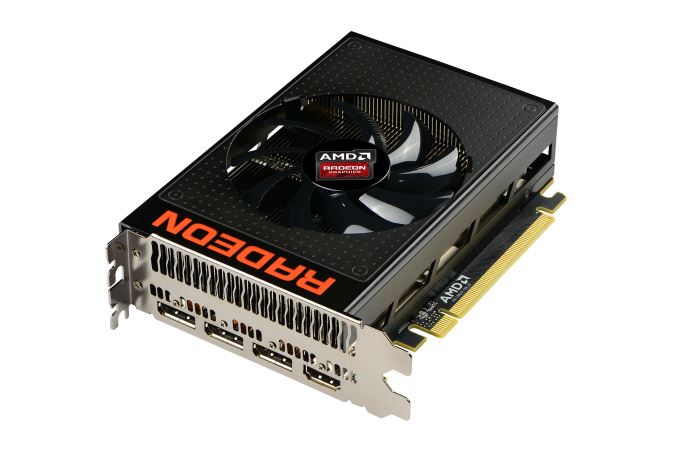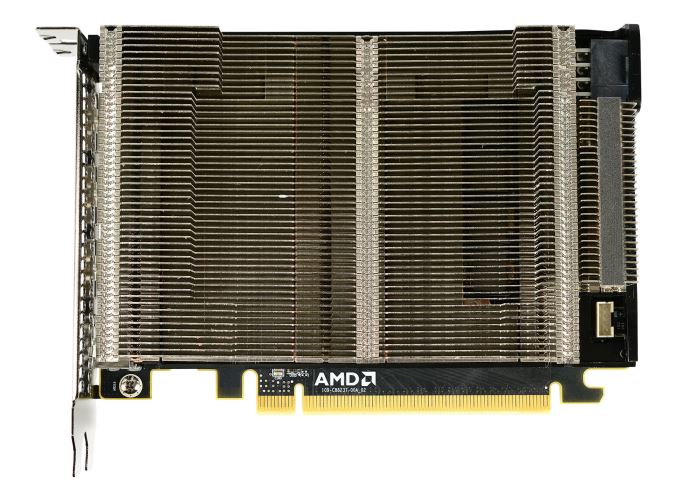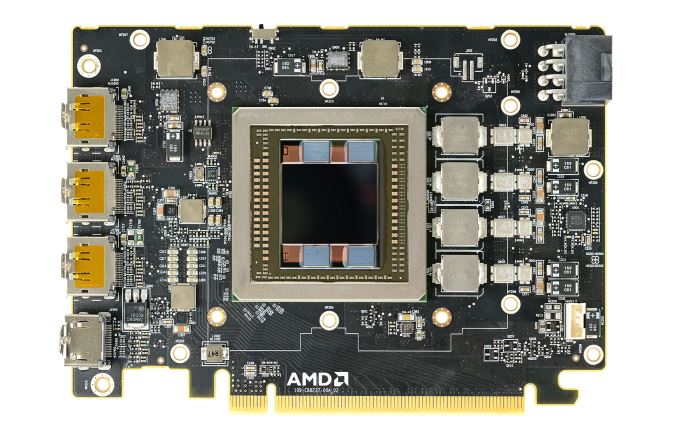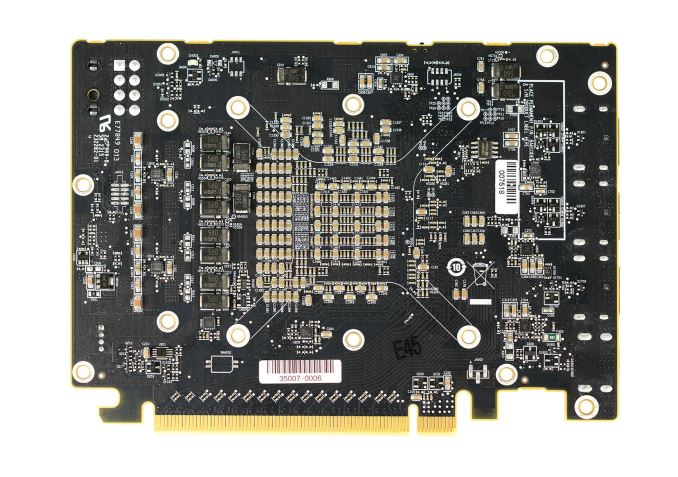The AMD Radeon R9 Nano Review: The Power of Size
by Ryan Smith on September 10, 2015 8:00 AM ESTMeet The Radeon R9 Nano
6 inch video cards are by no means a new thing in the GPU space, however these are traditionally lower-end products that need neither a large cooler nor an extensive power delivery system. As a result the R9 Nano is something of an interesting aberration, packing a lot more power and a lot more technology into half a foot of video card than what we normally see.
Starting as always from the top, the R9 Nano measures 6” long, which is actually a bit shorter than the full length the Mini-ITX standard allows. Responsibility for cooling the card falls to the R9 Nano’s new open air cooler, an aggressive design that has been specifically tailored to allow the card to effectively dissipate 175W of heat in such a small space.
The overall design of the R9 Nano’s cooler is best described as a combination open-air and half-blower hybrid. The design is technically open-air, employing a single axial fan to cool the card. However with only a single fan AMD has been able to align the heatsink fins horizontally and then place the fan in the center of the heatsink. The end result is that roughly half of the heat produced by the card is vented outside of the case, similar to a full blower, while the other half of the heat is vented back into the case. This reduces (though doesn’t eliminate) the amount of hot air being recycled by the card.
The heatsink itself is composed of aluminum and runs virtually the entire length of the card. This is technical a two-piece heatsink, with the primary heatsink composing the bulk of the card, while a much smaller secondary heatsink it found towards the far end of the card and mounted on top of a heatpipe.
Drilling down, we find that the primary heatsink is fed by a combination vapor chamber and heatpipe design. A copper vapor chamber serves to draw heat away from the Fiji GPU and HBM stacks, and then heatpipes are used to better distribute heat to the rest of the heatsink. The use of a vapor chamber in the R9 Nano makes a lot of sense given the fact that vapor chambers are traditionally the most efficient heatsink base type, however the R9 Nano is also unique in that we typically don’t see vapor chambers and heatpipes used together. Other designs such as the high-end GeForce series use a single large vapor chamber across the entire heatsink base, so among reference cards at least the R9 Nano stands alone in this respect. In this case given AMD’s design goals for size and noise, a vapor chamber will play a big part in helping the small card effectively and quietly dissipate 175W.
As for the physical PCB itself, as we can see AMD made it a relatively packed card in order to get the R9 Nano down to 6 inches. Compared to the R9 Fury X reference board, the biggest change here is that AMD has removed a fair bit of power circuitry to save space. By our count there are 4 VRM phases to feed the Fiji GPU, as opposed to the 6 found on R9 Fury X. Power delivery is handled by a single 8-pin PCIe power socket, which is becoming increasingly common, replacing the 2x 6-pin setup for 150W-225W cards.
Meanwhile to further shrink the overall PCB footprint, AMD has moved some of the remaining power delivery circuitry to the back of the card. The front of the card still contains the inductors and heat-sensitive MOSFETs, while a number of capacitors are on the rear of the card (and is why you won’t find a backplate).
Finally, for display I/O R9 Nano is unchanged from R9 Fury X. This means we’re looking at a DVI-free design, with 3x DisplayPort 1.2 and 1x HDMI 1.4 port all along a single row of the I/O bracket. Buyers looking to put together HTPCs will want to be especially mindful of the HDMI 1.4 port; while it's not necessarily a deal-breaker, it does mean that the R9 Nano can't fully drive 4Kp60 TVs, which are slowly but surely becoming more common.
Overall AMD is rather confident in their design for the R9 Nano. The heatsink is built to efficiently dissipate more heat than the 175W the card requires (despite the small size), and as a result we never see the R9 Nano thermally throttle under normal operation. The card’s thermal throttle point is 85C, and in our testing the card never passed 75C, exactly as AMD promised us. What ends up limiting the R9 Nano’s performance then is exactly as expected: the power throttling.
















284 Comments
View All Comments
Will Robinson - Thursday, September 10, 2015 - link
Yup,I agree.Dammed with faint praise is the best you'll see for AMD cards there.
Their comments section is an NV fanboy fest led by Chuckula/Chizow and approved by TR.
silverblue - Friday, September 11, 2015 - link
Semiaccurate would've most likely gone the same way had Charlie not locked it all down to subscribers. The only downside is the lack of a daily drashek fix.I think wccftech is another of chizow's haunts, but don't quote me on that.
Gasaraki88 - Friday, September 11, 2015 - link
Oh come on. AMD didn't give a card to Kyle from HardOCP also. So you're saying all the review sites out there are bias against AMD?jardows2 - Friday, September 11, 2015 - link
After reading several recent H's reviews of AMD products, where their testing shows the AMD card slightly slower than the nVidia product, then the conclusion stating the AMD product is a piece of trash and not worth anyone's money, without any of their own testing data backing up such a harsh conclusion, I don't blame AMD for not sending them a card.Alexvrb - Friday, September 11, 2015 - link
Yeah I kind of saw that one coming. I still read H sometimes, but you really have to draw your own conclusions and keep the salt handy. With TR, it's not only what they report, it's what they refuse to report. It's far from the worse, but there's a pattern.AT is my favorite overall, anyway.
InquisitorDavid - Saturday, September 12, 2015 - link
I don't know what your level of 'recent' is, but the R9 380 and R9 390x both got decent reviews. The 390x got a silver award, basically being touted as a cheaper, more power-hungry 980 with more VRAM (truth), and the R9 380 was given a Gold award because it performed better than a 960 at the same price range.The Fury got no awards for being on-par with the stock 980, while costing more. They saw the 390x having better value (thus the silver award), despite the increased power draw.
If anything, AMD has been getting a lot of crap because they've been losing for a while now. Less efficiency, rebrands, and all. OC'ing the 390x gets it to the same level as a 980 reference, and will consume about 200w more. It's cheaper, however, and we all know that's what AMD has been doing for a while now - value for money. It's the only battlefield they can claim any sort of real victory on. With the Fury and Nano, that gets completely thrown out the window.
The Fury X was hamstrung by the release of the 980ti (which was clearly a blocking maneuver by NV). Without the 980ti, it would've been the king of value. The "overclocker's dream" statement was still a bald-faced lie.
althaz - Monday, September 14, 2015 - link
If prices are equal and the AMD card is slightly slower, then the AMD card *IS* worthless. Who would pay the same money to get slightly worse performance and use more power? Only idiots.althaz - Monday, September 14, 2015 - link
Anybody that hasn't been pro-nVidia for the past few years has been doing it wrong. AMD have been using more power to offer less performance (at similar prices) - they have been behind for *ages* now. They still are, but at least it looks like HBM will bring the performance needed (next generation probably, it's obviously not there yet).anubis44 - Thursday, October 8, 2015 - link
I like TechReport, and find their coverage of tech very detailed, but yes, I have to agree with you that they've essentially been portraying AMD as just not quite as good as nVidia, yet all the while minimizing or ignoring the Green Goblin's dubious business practices ($200 G-Sync tax) and misrepresentation of their products (the 3.5GB GTX970 that somehow didn't completely torpedo that card's recommendation).Frenetic Pony - Thursday, September 10, 2015 - link
I've looked at Tech Report, fuck Tech Report. None of their tests seem to reflect anyone elses, I tried a few of the graphs and they're literally a statistical outlier (at least for my quick tests).